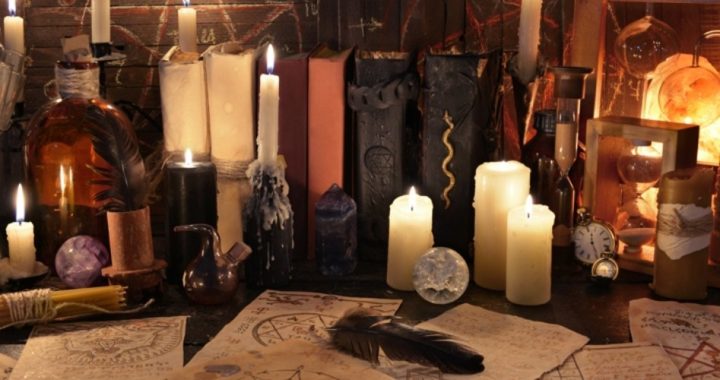
Following an old pattern, when people in our time cease believing in God, it’s not that they start to believe in nothing. It’s that they’ll believe in anything.
This sentiment, expressed by Belgian poet Émile Cammaerts, can come to mind with news that Americans identifying as Wiccan or pagan now outnumber Presbyterians. It gives new meaning to “that old-time religion.”
As the Daily Mail reports:
A survey by the Pew Research Center found that 0.4 per cent of Americans, between 1 and 1.5 million — identify as Wicca or Pagan, according to Quartz.
That means there are now more witches in the US than there are Presbyterians[,] who have around 1.4 million adherents.
Experts believe that the explosion in the witch population is due to millennial women’s embracing of new-age spirituality, mindfulness, meditation, and yoga.
Wicca, also called Witchcraft or The Craft, is a Pagan religion which emerged in Britain in the early 20th century. Based on ‘pre-Christian traditions,’ it was popularized by a retired British civil servant named Gerald Gardner throughout the 1950s and 1960s.
Wicca adherents praise nature and nature’s gods and goddesses.
… Experts say that one does not need to be a Wicca or Pagan in order to be a witch, meaning that the actual number of those who practice witchcraft may be higher.
But perhaps one does need to have an attitude. New York City witches vowed to get together October 20 to put a “hex” on new Supreme Court justice Brett Kavanaugh, along with “all rapists” and “the patriarchy,” the latter being another myth witches apparently embrace. Then there are the #MagicResistance witches, who e-gather every month in the Internet ether to cast a spell on President Trump.
The allure of witchcraft isn’t hard to grasp: the promise of power and freedom from moral constraints. Entertainment has glamorized witches in recent decades via films and shows such as American Horror Story: Coven, Charmed, and Bell Book and Candle, whose portrayal of women possessing great supernatural “power” is seductive to many girls. As one female commenter here writes of Bell Book and Candle, “I always wanted to be the main character.”
The Craft (1996), in particular, will appeal to any girl whose fury is, well, “like a woman scorned.” It portrays a group of teen witches with the power to exact brutal vengeance upon those who find their disfavor (video below. Note: one instance of foul language).
Now, it’s a red flag when something promises “power” because, as with any temptation, it is a tool of seduction. Note that Christianity doesn’t peddle personal power but personal sacrifice, not the craft but the cross. In contrast, the allure of modern paganism is a bit reminiscent of the original tempter and original temptation, the Devil and his lie in the Garden of Eden: Do as I prescribe “and you can be like God.”
Thus is it unsurprising that millennials are embracing witchcraft and paganism and are turning “away from Christianity and other traditionally dominant Abrahamic religions,” as Newsweek writes. Seduction is seductive.
Another seduction is eternal absolution. The disobedient child inside man doesn’t like being told “No!” He doesn’t like all the thou-shalt-nots. Christianity does one thing religion is supposed to do: It upholds a non-negotiable standard of behavior, reflecting the Truth, informing that sin really is real and that we really are wrong when indulging it.
This means that we must relinquish sin — even when strongly attached to it — or live with the guilt (assuming one’s conscience isn’t numbed) of doing wrong and the knowledge that we’ll be held accountable. It means accepting the Truth and conforming our lives to it.
So it’s easier for many, or so they feel, to embrace what someone close to me called “designer religion” and do just the opposite: Say “This is the lifestyle I want to live; now let me find a ‘belief system’ that accommodates it.” Ergo, paganism.
Speaking of which, it’s ironic that modern “pagans” call themselves just that. For the word derives from the Latin term paganus, which in Roman times meant “incompetent soldier” and was later applied to pagans, by Christians, as a pejorative. Ancient pagans might have been followers of the cult of Mithras or something else specific. But they didn’t call themselves “pagans” any more than today’s Catholics would call themselves papists or mackerel snappers.
This designer-religion movement and rejection of Christianity is wholly logical, though, given our descent into moral relativism. I often cite a Barna Group study showing that, in 2002 already, only six percent of teenagers believed in Truth (absolute by definition) and that they were most likely to make “moral” decisions based on feelings.
How is this relevant? Moral relativism holds that what we call “morality” is determined by the man; what this actually means, however, is that morality (properly defined) doesn’t really exist — only man’s preference does.
This strikes at Christianity’s very heart because it renders the sacrifice on the cross incomprehensible. After all, if there’s no Truth and all is preference, there is no sin. If there’s no sin, there was no reason for Jesus to die for us. This means there is no need for salvation and, hence, no need for Christianity.
So given the relativism the young have been marinated in, their behavior is entirely rational. Why, if I believed all was preference, just a flavor of the day, why would I constrain my impulses with the Christian moral standard or any other? I should rather be a hedonist.
Witchcraft is seductive to some, scary or stupid to others. It is the “If it feels good, do it” credo more than spells, however, that could spell doom for the West.
Image: VeraPetruk via iStock / Getty Images Plus



